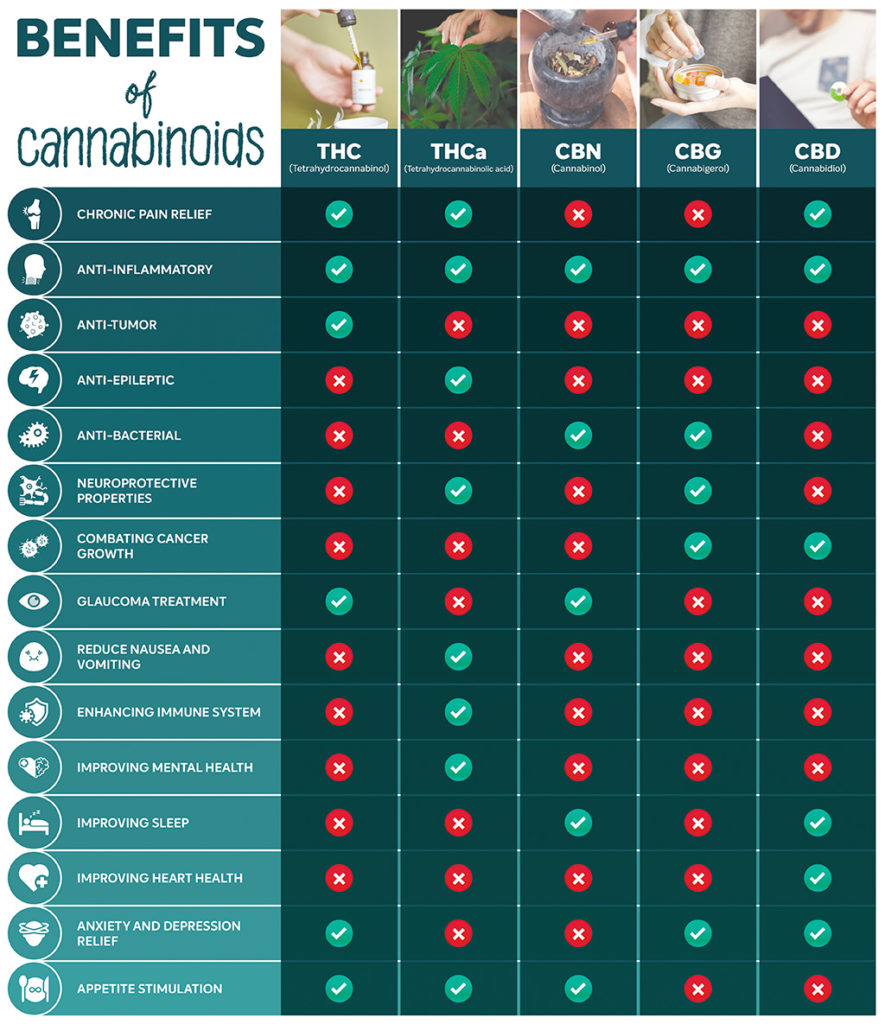
Who knew there were different types of cannabinoids with unique benefits worth exploring? Cannabinoids are chemical compounds that occur naturally in the cannabis plant. They’re why marijuana has many effects on the body and mind. THC is one of the most prevalent cannabinoids, which is the reason behind the “high” that people experience when they consume cannabis.
Cannabinoids offer several therapeutic effects, and there are over 100 different of them, each with its unique effects. For example, CBD is non-psychoactive and, as per many credible studies, is known to have several potential health benefits, such as reducing anxiety and inflammation. CBN is known for its sedative properties, making it a popular choice for people looking for relief from insomnia. And then there’s THCa, which is non-psychoactive but has anti-inflammatory properties.
Essentially, cannabinoids are the building blocks of the cannabis plant. So next time you hear about cannabinoids, just think of them as a superhero team of the cannabis world!
Today, we’ll take a fun and informative walkthrough of the types of cannabinoids and learn their potential benefits. So, grab a seat, relax, and let’s get started on our cannabinoid journey!
How Do Cannabinoids Work?

Cannabinoids interact with the body’s endocannabinoid system (ECS), a network of receptors found throughout the body. The two primary receptors in the ECS are CB1 and CB2. CB1 receptors are mainly present in the brain and central nervous system, while CB2 receptors are primarily in the immune system.
The ECS controls various physiological events, including inflammation, mood, pain, and memory. When cannabinoids bind to these receptors, they can produce multiple effects, including pain relief, anti-inflammatory effects, and mood changes. The results of cannabinoids can differ according to the type of cannabinoid and the individuals.
Understanding the Different Types of Cannabinoids
From THC to CBD and everything in between, we’ll break it all down for you in an easy-to-understand way. Before we dive into the details of the different types of cannabinoids, here’s a little preview of the benefits that they potentially offer:

THC (Tetrahydrocannabinol)
The credit for the subtle buzz you feel after cannabis consumption goes to THC. It is the primary psychoactive compound found in the cannabis plant. THC binds to the CB1 receptors in the brain and central nervous system, which leads to changes in perception, mood, and other cognitive and physical effects. There are different forms of THC–Delta 8 THC is a minor cannabinoid found in smaller amounts in the cannabis plant, while Delta 9 THC is the most abundant and well-known form of THC found in cannabis.
Studies Reveal the Effects of THC as Follows:
Chronic pain: THC effectively reduces chronic and neuropathic pain, which can be challenging to manage with traditional pain medications.
Appetite stimulation: It can increase appetite and benefit anyone who has difficulty eating due to conditions such as HIV or cancer.
Anti-inflammatory: People with rheumatoid arthritis or multiple sclerosis are grateful to THC as it significantly reduces inflammation.
Anti-tumor: Studies have shown that THC may have anti-tumor effects, which can help reduce the growth of certain types of tumors.
Anxiety and depression relief: It has been shown to positively affect mood, which can help alleviate symptoms of anxiety and depression.
Glaucoma treatment: It can help reduce the pressure inside the eye, which is suitable for people with glaucoma.
THCa (Tetrahydrocannabinolic acid)
It is a non-psychoactive cannabinoid in the cannabis plant. It’s the precursor to THC, the compound known for its psychoactive effects. THCa is present in raw and live cannabis and only converts to THC when exposed to heat through smoking or vaporizing.
THCa has potential anti-inflammatory and neuroprotective properties. So, does THCa get you high? This is where you have to understand the difference between THC and THCa. THCa may not get you “high” as THC does, but it still packs a therapeutic punch! Let’s look at THCa benefits.
Studies Reveal the Effects of THCa as Follows:
Anti-inflammatory: THCa has anti-inflammatory properties, which may help with conditions such as arthritis and Crohn’s disease.
Neuroprotective properties: Its neuroprotective properties are also beneficial for treating conditions such as Alzheimer’s and Parkinson’s.
Immune system: The immune system’s functioning can be enhanced by THCa. The subsequent effect can help treat autoimmune diseases.
Pain relief: It may also help with pain management and muscle spasms.
Increases appetite: THCa has been shown to improve appetite and help weight gain in people with HIV/AIDS.
Mental health: It can also help treat symptoms of PTSD and other mental health conditions.
Anti-epileptic: It helps control seizures in people with certain types of epilepsy.
Nausea and vomiting: THCA can help reduce nausea and vomiting caused by chemotherapy.
CBN (Cannabinol)
While it’s not as popular as CBD or THC, CBN is starting to gain more attention for its potential medicinal benefits. It is a minor cannabinoid present in the cannabis plant. It’s known for its sedation effects and is particularly effective in treating insomnia. So, the next time you struggle with sleepless nights, you know that weed can help you fall asleep instantly.
But here’s the fun part: CBN is formed when THC (tetrahydrocannabinol) is exposed to light and heat over time. So, because of THC, it’s got some wise and calming qualities. Who knew that letting your buds sit in the sun for too long could have such benefits?
Studies Reveal the Effects of CBN as Follows:
Anti-insomnia: CBN is known for its sedative properties and could be beneficial as a sleep aid.
Anti-inflammatory: It has shown anti-inflammatory effects, which may help with conditions such as arthritis and irritable bowel syndrome.
Appetite stimulation: It can help stimulate appetite, which can be helpful for people who have lost their appetite due to medical or mental health conditions.
Antibacterial: It has some antibacterial properties, which may help to fight off certain types of bacteria.
Glaucoma treatment: It can lower intraocular pressure, making it a potential treatment for glaucoma.
CBG (Cannabigerol)
It is a non-psychoactive cannabinoid found in hemp and cannabis plants. It’s often referred to as the “stem cell” of cannabinoids because it’s the precursor to other popular types of cannabinoids like THC and CBD.
Preliminary Results Reveal the Effects of CBG as Follows:
Anti-inflammatory: CBG has been shown to reduce inflammation in the body, which can help alleviate pain and discomfort associated with conditions like arthritis and IBS.
Antibacterial: CBG is known to have strong antibacterial properties, which can help fight off bacterial infections and promote overall health.
Neuroprotective: It has neuroprotective properties, which could help treat conditions such as Huntington’s disease.
Depression and anxiety treatment: It has anti-anxiety and anti-depressant properties, which can help alleviate symptoms of depression and anxiety and promote calmness and relaxation.
Cancer growth: CBG has been found to have anti-tumor properties and can inhibit the growth of certain types of cancer cells.
CBD (Cannabidiol)
It is one of the most well-known and widely studied compounds in the cannabis plant and is known for its potential therapeutic properties. CBD’s most commonly cited medical benefits include its ability to reduce inflammation, relieve pain, improve sleep, and reduce symptoms of anxiety and depression.
So whether you’re looking to ease anxiety or just give your body extra support, CBD might be worth considering. It can be taken in various forms, including oils, capsules, and even gummies, making it a convenient option for those looking to incorporate it into their wellness routine.
Preliminary Results Reveal the Effects of CBD as Follows:
Pain relief: It has pain-relieving properties, which can be helpful for conditions such as arthritis, multiple sclerosis, and chronic pain.
Reducing anxiety and depression: It has positively impacted mental health conditions such as anxiety and depression.
Improving heart health: CBD has been linked to a decrease in blood pressure, which can help reduce the risk of heart disease.
Reducing inflammation: It has anti-inflammatory properties, which can be helpful for conditions such as irritable bowel syndrome and inflammatory skin conditions.
Improving sleep: It can help improve sleep in individuals with insomnia and other sleep disorders.
Combating cancer-related symptoms: Some studies have suggested that CBD may potentially treat cancer-related symptoms such as nausea, vomiting, and pain.
Final Thoughts on Cannabinoids

So there you have it, folks, the rundown on the five major types of cannabinoids. With this, you’ve been welcomed to the world of edible cannabinoids. From THC to THCa, CBG to CBD, we’ve covered the basics of these magical molecules and their potential benefits. So, whether you’re a cannabis connoisseur or a curious beginner, you can make informed decisions about incorporating cannabinoids into your diet. Knowing what you’re putting into your body is essential, whether you’re using it for recreational or medicinal purposes. Remember, next time you’re shopping for cannabis products, keep an eye out for these types of cannabinoids and see how they can benefit you! Happy munching!

